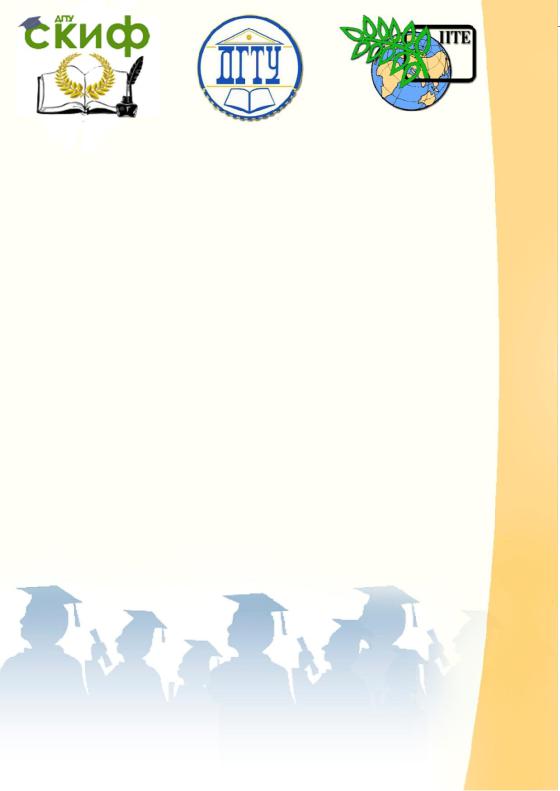
Методичка по английскому
.pdf
ДОНСКОЙ ГОСУДАРСТВЕННЫЙ ТЕХНИЧЕСКИЙ УНИВЕРСИТЕТ
УПРАВЛЕНИЕ ДИСТАНЦИОННОГО ОБУЧЕНИЯ И ПОВЫШЕНИЯ КВАЛИФИКАЦИИ
Кафедра «Научно-технический перевод и профессиональная коммуникация»
Учебное пособие
по дисциплине
«Иностранный язык в профессиональной сфере»
Авторы Бронзова Ж.Е., Шелковникова С.В., Горгадзе Л.Н.
Ростов-на-Дону, 2015

Управление дистанционного обучения и повышения квалификации
Иностранный язык в профессиональной сфере
Аннотация
Данное учебное пособие предназначено для студентов направления 12.03.01 «Приборостроение», изучающих английский язык.
Цель пособия – познакомить студентов с базовой профессиональной терминологией, закрепить навыки чтения и перевода, развить навыки реферирования и аннотирования специальных текстов на английском языке. Текстовый материал пособия аутентичен и подобран в соответствии с темами и уровнем сложности.
Авторы
к.пед.н., доцент Ж.Е.Бронзова, ст. преподаватель С.В.Шелковникова, преподаватель Л.Н.Горгадзе

Управление дистанционного обучения и повышения квалификации
Иностранный язык в профессиональной сфере
Оглавление
Unit 1........................................................................................ |
|
4 |
Text 1. Instrumentation engineering .................................. |
4 |
|
Text 2. |
Instrumentation in Russia...................................... |
6 |
Unit 2 Measurements and measuring instruments ............. |
10 |
|
Text 1 Measurements ....................................................... |
10 |
|
Text 2 |
Electronics and electrical engineering ..................... |
11 |
Unit 3 Oscilloscope................................................................. |
14 |
|
Text 1 Read and translate the following text. ..................... |
14 |
|
Types and models ............................................................ |
16 |
|
UNIT 4 .................................................................................... |
|
19 |
Text 1. |
AN AMMETER ..................................................... |
19 |
Text 2. TYPES OF AMMETERS ......................................... |
20 |
|
Text 3. APPLICATION OF AMMETERS ............................. |
24 |
|
VOLTMETER .................................................................... |
26 |
|
UNIT 5 .................................................................................... |
|
28 |
ANTENNA ........................................................................ |
28 |
|
TERMINOLOGY ................................................................ |
30 |
|
CATEGORIES OF ANTENNAS............................................. |
32 |
|
ANTENNA ARRAYS ........................................................... |
35 |
|
CHARACTERISTICS .......................................................... |
38 |
|
UNIT 6 .................................................................................... |
|
42 |
LASER ............................................................................. |
|
42 |
LASER PHYSICS ............................................................... |
44 |
|
AS WEAPONS................................................................... |
49 |
|
Лексические модели, которые можно использовать при |
||
реферировании текстов на английском языке: ....................... |
52 |
|
Литература............................................................................ |
|
53 |
3

Управление дистанционного обучения и повышения квалификации
Иностранный язык в профессиональной сфере
UNIT 1
Text 1. Instrumentation engineering
Vocabulary:
instrumentation engineering – приборостроение domain – область, сфера
reliability – надежность accuracy – точность longevityдолговечность robustnessпрочность capacityвместимость techniquesтехника, методы
troubleshootingвыявление неисправностей measureмера, измерение; измерять deviceприбор, устройство
solenoidсоленоид valveклапан
circuit breakerавтоматический выключатель, прерыватель
Ex.1 Read and translate the following text.
Instrumentation engineering is the engineering specialization focused on the principle and operation of measuring instruments that are used in design and configuration of automated systems in electrical, pneumatic domains etc. They typically work for industries with automated processes, such as chemical or manufacturing plants, with the goal of improving system productivity, reliability, safety, optimization, and stability. To control the parameters in a process or in a particular system, devices such as microprocessors, microcontrollers or PLCs are used, but their ultimate aim is to control the parameters of a system. Instrumentation is the use of measuring instruments to monitor and control a process. It is the art and science of measurement and control of process variables within a production, laboratory, or manufacturing area.
Instrumentation engineering is loosely defined because the required tasks are very domain dependent. An expert in the biomedical instrumentation of laboratory rats has very different concerns than the expert in rocket instrumentation. Common concerns of both are the selection of appropriate sensors based on size, weight, cost, reliability, accuracy, longevity, environmental robustness and frequency re-
4

Управление дистанционного обучения и повышения квалификации
Иностранный язык в профессиональной сфере
sponse. Some sensors are literally fired in artillery shells. Others sense thermonuclear explosions until destroyed. Invariably sensor data must be recorded, transmitted or displayed. Recording rates and capacities vary enormously. Transmission can be trivial or can be clandestine, encrypted and low-power in the presence of jamming. Displays can be trivially simple or can require consultation with human factors experts. Control system design varies from trivial to a separate specialty.
Instrumentation engineers are commonly responsible for integrating the sensors with the recorders, transmitters, displays or control systems. They may design or specify installation, wiring and signal conditioning. They may be responsible for calibration, testing and maintenance of the system.
In a research environment it is common for subject matter experts to have substantial instrumentation system expertise. An astronomer knows the structure of the universe and a great deal about telescopes - optics, pointing and cameras (or other sensing elements). That often includes the hard-won knowledge of the operational procedures that provide the best results. For example, an astronomer is often knowledgeable of techniques to minimize temperature gradients that cause air turbulence within the telescope.
Instrumentation technologists, technicians and mechanics specialize in troubleshooting and repairing and maintenance of instruments and instrumentation systems.
An instrument is a device that measures a physical quantity such as flow, temperature, level, distance, angle, or pressure. Instruments may be as simple as direct reading thermometers or may be complex multi-variable process analyzers. Instruments are often part of a control system in refineries, factories, and vehicles. The control of processes is one of the main branches of applied instrumentation. Instrumentation can also refer to handheld devices that measure some desired variable. Diverse handheld instrumentation is common in laboratories, but can be found in the household as well. For example, a smoke detector is a common instrument found in most western homes.
Instruments attached to a control system may provide signals used to operate solenoids, valves, regulators, circuit breakers,
or relays. These devices control a desired output variable, and provide either remote or automated control capabilities. These are often referred to as final control elements when controlled remotely or by a control system.
5

Управление дистанционного обучения и повышения квалификации
Иностранный язык в профессиональной сфере
Ex.2 Match the words of group A with the words of group B having similar meaning.
A.concentrate, manufacturing, register, work, demand, application, goal, instrument, structure, break
B.production, use, focus, destroy, device, record, aim, operation, design, require
Ex.3 Complete the following sentences with the information from the text.
1.Instrumentation engineering is loosely defined be-
cause … .
2.Instrumentation engineers are responsible for… .
3.An instrument is a device that… .
4.Instrumentation technologists, technicians and mechanics specialize in …. .
Ex.5 Answer the questions.
1.How can instrumentation engineering be defined?
2.What spheres of industry do instrumentation engi-
neers work?
3.What functions do they perform?
4.Do technologists, technicians and mechanics design
instruments?
5.What quantities/ parameters can modern instruments
measure?
Text 2. Instrumentation in Russia
Vocabulary: weigh-scales -весы enterprise - предприятие concern - концерн
avionics – авиационная радиоэлектроника
warfare and intelligence equipment – военно-
разведывательное оборудование friend-or-foe – система «свой-чужой» plug – затвор, цилиндр
supplier -поставщик arms - вооружение means – средства
6

Управление дистанционного обучения и повышения квалификации
Иностранный язык в профессиональной сфере
Ex.1 Read and translate the following text.
In Russia instrument engineering is the branch of machinebuilding industry that develops and manufactures devices for measurement, processing and providing information, automatic and automated control systems.
It was not until 1929 that instrument engineering began its development as there were only several small factories producing thermometers, manometers, weigh-scales and other measuring instruments. The process of industrialization boosted the industrial development of this branch in 1929-1932.
Nowadays Russian instrument building plants present one of the most productive branches of modern industry experiencing the stage of active growth and comprising more than 30 enterprises. The largest ones are located in Barnaul, Novosibirsk, Krasnodar and Moscow.
For example, Concern Radio-Electronic Technologies (KRET) is the major Russian center of word-class instrument engineering. It is a subsidiary of the state corporation Rostec. Presently, KRET unites more than 95 enterprises and organizations engaged in the development and production of military and civil radio-electronic products. The enterprises of the Concern are located across Russia, from Saint Petersburg to Vladivostok, and the total number of employees exceeds 50,000 people.
Currently, KRET produces a wide range of products, which may be classified as follows:
avionics, operational and tactical systems;
electronic warfare and intelligence equipment (EW and
ELINT);
friend-or-foe identification systems and equipment (IFF);
special measuring instrumentation (MI);
plugs, electric connectors, and cable products.
A significant share of the Concern’s revenues comes from avionics and operational systems. KRET controls approximately 40% of the military avionics market. The Concern is developing avionics for the leading Russian aircraft, including Su-35S, Ka-52 Alligator, Mi171A2, Yak-130, Il-476, and Tu-204SM, the most modern Russian line aircraft, as well as the Soyuz-TMA spacecraft. Thus, KRET is a supplier for the major Russian aircraft producers, such as United Aircraft Corporation and Russian Helicopters. Currently, the enterprises of the Concern are among the world7leaders and the top Russian de-

Управление дистанционного обучения и повышения квалификации
Иностранный язык в профессиональной сфере
signers and producers in the field of electronic warfare equipment and suites, as well as IFF systems, which have no foreign equivalents. KRET is the designer of one of two IFF radar systems that exist in the world, Parol, which is used by Russia and the CIS countries (the second MK-12 radar IFF system is used by the USA and NATO members).
A notable trend in the business of the Concern is the significant increase in production of military electric connecters and cables, as well as the extension of the range of civil products. One of the goals of the Concern is to enter the world market of the plug connecter suppliers for major international companies, and particularly for Airbus.
High-tech products of KRET enterprises are available within the framework of the state arms program and state defense order, as well as international treaties in the field of military and technical cooperation. Even today, the products of the Concern are supplied to 30 countries of the world.
A significant amount of scientific production centers specializing in inventing radio-electronic production has entered into the activities transferred to the state corporation Rostec founded in 2007. It was decided to unite them within the framework of a holding company: concern.
In January 2009 an order was issued by the state corporation Rostec on the founding of JSC Concern Radioelectronic Technologies, in which a list of companies and organizations transferable to join the concern of companies and organizations of Russia’s radioelectronic branch. A month later, on February 19, 2009, JSC Concern Radio-Electronic Technologies (KRET) was registered. This date is considered the company’s founding date.
Over fifty companies initially joined the Concern, on the base of which primary new holding jurisdictions were formed:
-Technical complex developers and producers of the radiotechnologic opposition entered into the group of companies along the time of the radio-electronic fight. The main production company OJSC Research-Production Enterprise Kvant was the head production company and JSC Kaluzhsky Scientific Research Radio-Technical Institute the leading scientific research organization;
-State radiolocation identification means and complexes developers and producers entered into the group of companies working in the sphere of state identification. JSC NPO V.I. Shimko Radioelectronics was the head organization;
- The integration of developers and producers of electric
8

Управление дистанционного обучения и повышения квалификации
Иностранный язык в профессиональной сфере
adapters and special function cable assemblies entered within the framework of the Cables and Adapters movement. A number of companies entered into this unit, amongst which JSC Zavod Elecon and
JSC Design Bureau of the Cable Industry, two of Russia’s biggest special electric adapter and cable development and production companies, stand out.
A group of diagnostic control system and special measuring apparatus developer companies and producers was also formed. Among others JSC Federal Scientific Production Center Institute of Electronic Measurements Kvarz, one of the biggest centers in Russia on special radio-electric measuring apparatus development and production, joined it.
The Concern’s successes in forming a modern model of an effective scientific production structure have been recognized by the Russian government. At the end of 2012 by decision of Rostec’s observation council a new direction of activity was added to the already existing production range: the development and production of board radio-electronic hardware and avionics for military, transport, and civil aviation. Companies, which were previously members of JSC Concern
Aviapriborostroenie, were transferred to under KRET’s leadership.
Even today KRET is one of the biggest holding companies in Russia, which unites over 95 radio-electronic industrial companies. Their activity is connected with the development and production of a means of radio-electronic battle and development, state identification, board radio-electronic equipment complexes and systems, special function measuring apparatuses, and also electric adapter plugs and cable production.
Ex.2 Find the Russian equivalents for the following phrases.
1.machine-building industry
2.automated control systems
3.radio-electronic products
4.operational and tactical systems
5.board radio-electronic hardware
6.civil aviation
7.measuring apparatus developer
8.a notable trend
Ex.3 Give the summary of Text 2.
9

Управление дистанционного обучения и повышения квалификации
Иностранный язык в профессиональной сфере
UNIT 2 MEASUREMENTS AND MEASURING
INSTRUMENTS
Text 1 Measurements
Vocabulary:
dimensionвеличина, объем uncertainty- неточность wavelengthдлина волны precision - точность
error - ошибка stopwatch – секундомер
Ex.1 Read and translate the following text.
Measurement is the assignment of numbers to objects or events. It is a cornerstone of most natural sciences, technology, economics, and quantitative research in other social sciences.
Any measurement of an object can be judged by the following meta-measurement criteria values: level of measurement (which includes magnitude), dimensions (units), and uncertainty. They enable comparisons to be done between different measurements and reduce confusion. Even in cases of clear qualitative similarity or difference, increased precision through quantitative measurement is often preferred in order to aid in replication. For example, different colours may be operationalized based either on wavelengths of light or (qualitative) terms such as "green" and "blue" which are often interpreted differently by different people. The science of measurement is called metrology.
A measuring instrument is a device for measuring a physical quantity. In the physical sciences, quality assurance, and engineering measurement is the activity of obtaining and comparing physical quantities of real-world objects and events. Established standard objects and events are used as units, and the process of measurement gives a number relating the item under study and the referenced unit of measurement. Measuring instruments, and formal test methods which define the instrument's use, are the means by which these relations of numbers are obtained. All measuring instruments are subject to varying degrees of instrument error and measurement uncer-
tainty. |
|
|
Scientists, engineers and other humans use a |
vast range |
|
of instruments to |
perform their measurements. |
These in- |
|
10 |
|
